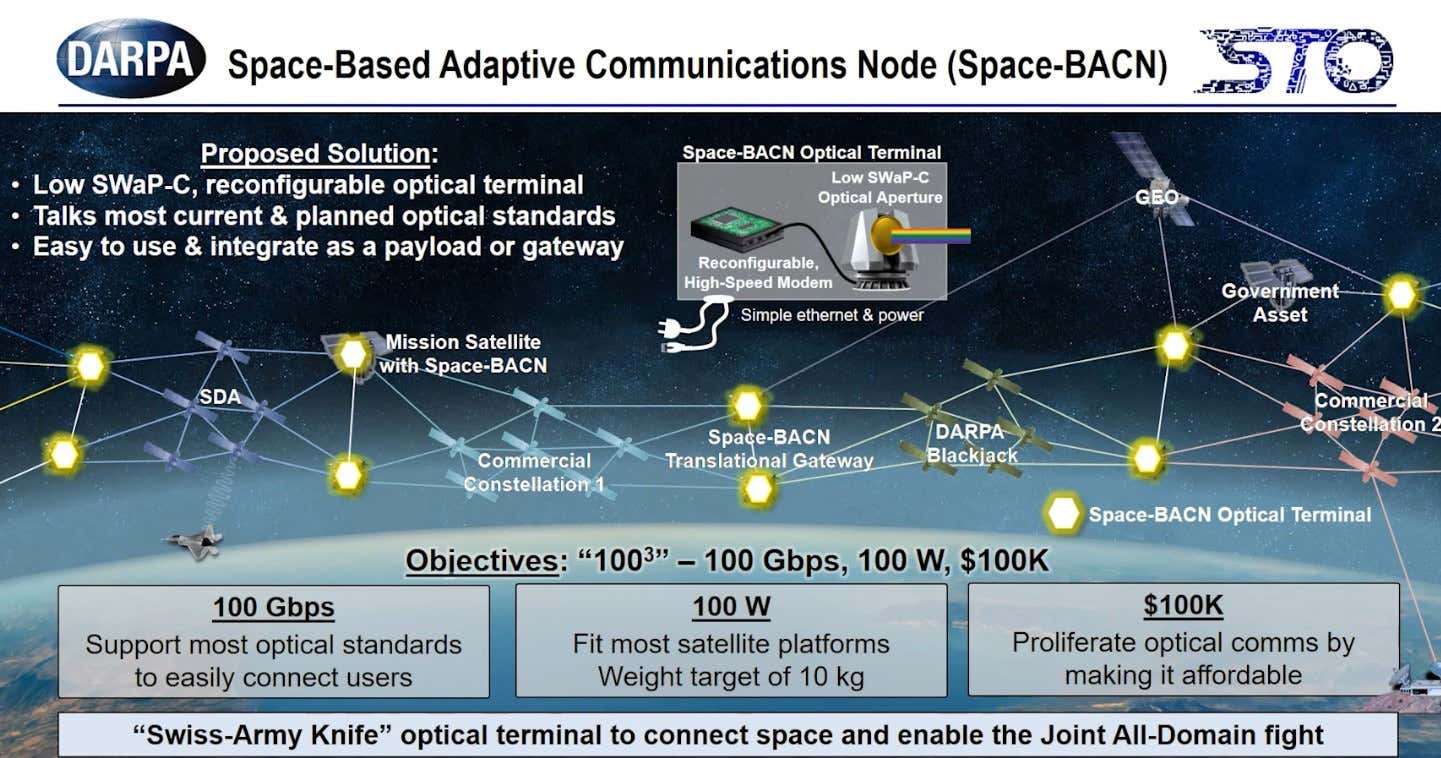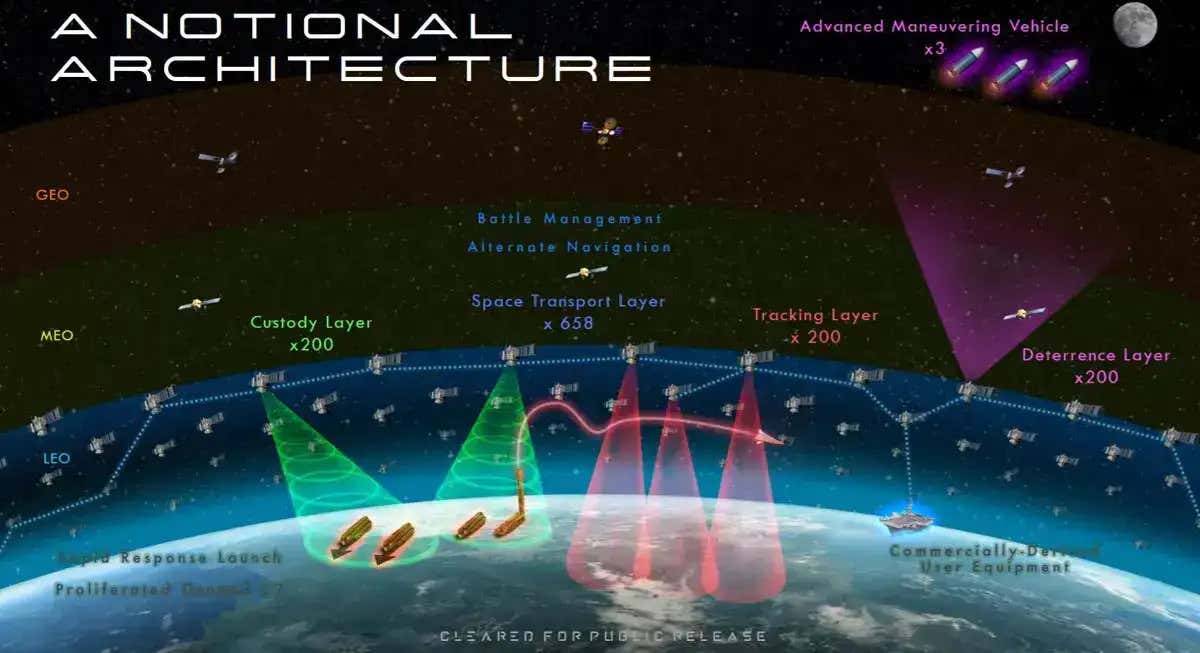
The U.S. military's Defense Advanced Research Projects Agency, or DARPA, has unveiled a new project to create a low-cost and readily reconfigurable optical communications system that will help ensure various satellite constellations can share large amounts of data quickly and securely.
The agency describes this effort, dubbed Space-Based Adaptive Communications Node, or Space-BACN, as being essential to linking together future distributed satellite networks, which are under development now to support various different, but often complementary missions, including early warning, intelligence gathering, and general communications and data-sharing.
DARPA revealed Space-BACN – the acronym is pronounced "bacon" – in a press release on Sept. 13, 2021. Despite the acronym, there is no indication that this project is, in any way, related to the U.S. Air Force's more down-to-earth E-11A Battlefield Airborne Communications Node (BACN) aircraft.
"Today, we are witnessing the birth of a new domain called proliferated space," Greg Kuperman, the Space-BACN Program Manager within DARPA’s Strategic Technology Office, explained in a video presentation, seen above, accompanying the press release. "In the upcoming years, we're going to see thousands of satellites going up into space that are low cost, rapid to field, and highly distributed."
“There could be tens of thousands of small satellites launched into LEO [low Earth orbit] over the next decade as the demand around the world for affordable space-based capabilities grows,” he added in a written statement. “The problem with this growth is that optical communications links are currently engineered to only connect satellites within a given constellation – they can’t dynamically adapt waveforms to communicate with satellites in other constellations.”
Kuperman added that, to date, only fixed-rate, single-mode optical communications systems, which use laser light as the mechanism for transferring information, have been demonstrated in space. Those nodes have been shown to be able to transfer large amounts of information very quickly, and do so in ways that are highly secure and jam-resistant, but are also often very costly.
“Traditional government optical terminals for coherent space-based optical communications can cost hundreds of thousands to millions of dollars due to the many precision designed and manufactured components that are hand assembled by highly skilled experts in the field,” Kuperman said. “Commercial space companies, on the other hand, are developing ultra-optimized, single-mode coherent systems designed to achieve high-rate communications while lowering cost. These lower-cost systems, however, are not reconfigurable nor compatible with any other standard.”
The lack of standardization has led to a "fragmented, stove-piped ‘Wild West’ space domain," according to Kuperman. That's where Space-BACN comes in. The project is seeking concepts that can produce an optical communications terminal with three core capabilities: a 100 gigabit-per-second transfer rate "to support most optical standards," a need for no more than 100 Watts of power generation, and a total cost of under $100,000. DARPA refers to these key requirements as “100 Cubed."
Space-BACN will explore proposals for three separate technologies that DARPA hopes it will be able to combine to form a system that meets the 100 Cubed requirements. The first of these is a low-cost optical aperture capable of handling all infrared wavelengths in the C band that will then feed into an affordable single-mode fiber optic line, offering low-cost, but also low-loss transmission capabilities in space. The second component is a reconfigurable modem that can support a variety of different waveforms. The last piece of the puzzle is a "cross-constellation command and control" architecture that can "automate interactions between government and commercial satellites," according to DARPADARPA also wants the entire package to be highly modular and leverage open-architecture systems to allow for components to be rapidly upgraded, or even swapped out entirely. This would enable the rapid integration of new and improved functionality as time goes on. Part of the overall low-cost goal is also for all three core technologies to be able to be produced relatively quickly in large quantities. The terminal itself could be installed on dedicated satellites acting as communications and data-sharing gateways or be integrated with various future satellites to give them this capability directly.

Graphics DARPA used to illustrate the desired modularity and open-architecture nature of the final Space-BACN terminal.
"Since Space-BACN is focused on operating in LEO, it will be able to take advantage of advanced low-cost electronics that can reliably operate in lower radiation environments and more easily connect to the large number of other government and commercial LEO satellite constellations," DARPA's press release said. "Additionally, the shorter expected life span of LEO satellites – three to five years – combined with the modularity of the Space-BACN terminal will facilitate rapid refresh cycles and insertions of new technology as it becomes available."
"The goal is to not make the perfect solution for everyone, but the good enough solution for most users," Kuperman added in the video presentation. Another infographic, seen below, describes the desires end result as a "Swiss-Army Knife"

The U.S. military alone has a number of small, distributed satellite constellation projects in progress now that could benefit from something like Space-BACN. DARPA itself is leading a project called Blackjack, which is seeking to demonstrate the feasibility of various components that would be necessary for a relatively low-cost constellation of small satellites in LEO capable of performing early warning and associated communications functions. A specialized data processor, nicknamed Pit Boss, is also being developed within this program to give the entire constellation a high degree of autonomy.
Separately, the U.S. Space Development Agency (SDA) is working on developing a fielding a new space-based early warning network made up of various "layers" of small satellite constellations. Each one of these layers will perform a different set of functions, from spotting and tracking various threats, including hypersonic weapons, to ensuring the rapid transmission of that data to command and control centers on the ground, which could then be used to attempt an intercept.

An infographic showing MDA's notional multi-layer National Defense Space Architecture.
These are just some examples of small satellite programs the U.S. military is working on as it explores ways to reduce the vulnerability of various space-based capabilities, which are currently provided by relatively small numbers of exquisite satellites. A growing number of terrestrial and on-orbit anti-satellite threats have underscored the need for distributed constellations to ensure to the highest degree possible that forces down below will continue to receive various kinds of critical space-based support, such as early warning, intelligence-gathering, navigation and weapon guidance, communications and data-sharing, and more, in any contingency.
Space-BACN presents a path toward the U.S. military being able to more rapidly leverage future commercial constellations to bolster its space-based capabilities and capacity, as well. The U.S. Air Force has already been working with private space firm SpaceX to explore how its Starlink satellites could be used to support military operations.
Optical communications terminals could also be used on aircraft flying within Earth's atmosphere. The War Zone specifically highlighted this potential application of this technology in our in-depth feature on what roles and missions that a secretive Air Force high-altitude, long-endurance (HALE) stealth drone commonly referred to as the RQ-180 is likely to have. The use of a laser-based satcom system has already been tested aboard MQ-9 Reaper, as well. Other initiatives are likely to exist in the classified domain.
In addition, DARPA's Kuperman said that low-cost optical communications terminals could be extremely beneficial for non-military uses, as well. In the video presentation, he specifically outlined a disaster response/humanitarian relief operations scenario where they could be applicable.
"Today, a lack of communications and sensing has hurt first responders' ability" to act quickly and get "help to people in need," he explained. "Imagery collected on one satellite system will not be immediately available to responders that are using a different one for communications. And if two teams of rescuers are using communications from two different satellites constellations, then they'll have limited ability communicate."
All told, the importance of optical communications, for space-based and other uses, has only been becoming more and more obvious in recent years. While highly specialized systems will still likely be necessary for at least some of those applications, DARPA, through the Space-BACN program, is now looking for ways to lower the cost of core elements of this technology to make it easier for various end-users to adopt it on a much broader scale.
Joseph Trevithick
No comments:
Post a Comment
Note: Only a member of this blog may post a comment.